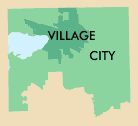Pewaukee Merger Study Outline and Budget
The Pewaukee merger study is being undertaken in several phases. The purpose of a phased approach is
as to enable the Merger Advisory Committee to recommend termination of the merger study at the end of any phase should the Committee be of the opinion that a mutually beneficial approach to the consolidation of the two municipalities cannot be found.
As identified in the accompanying chart, four phases of the study are envisioned. At the present time (Fall 2009), the study is in Phase IV. All costs incurred by the consultant team are being shared equally by the City and the Village.
|
Phase
Number |
Phase
Name |
Comments |
Consultant
Cost |
|
I |
Merged General Fund
Budget Preparation |
-
Work
undertaken by City and Village Administrators
|
No Cost |
- Principal
Finding:
Consolidation of City and Village could effect general fund cost savings of
at least $1.1 million assuming that about $409,000 in Village hydrant rental
expenditures were paid instead through utility fees as is the practice in the
City.
|
|
|
II |
Consolidation Tax
Rate Feasibility Analysis |
- Work
undertaken by consultant team of Municipal Economics & Planning
(Ruekert/Mielke) and Boardman Law Firm
|
$30,000 |
-
Principal
Finding:
There are several ways to structure a consolidation of the City and Village
so as to ensure that cost savings brought about by the consolidation can be
shared by both taxpayer groups, thereby reducing property tax rates for both
groups.
|
|
|
III |
Setting the Stage
for a Definitive Consolidation Proposal |
- Work
was undertaken by the above-referenced
consultant team
|
|
- Sanitary
Sewer and Water Utility Study
- Quantify possible
future capital cost avoidance by a utility merger
- Examine potential
availability of Village utility reserves for use in municipal consolidation
tax rate reduction, including impacts on future user charges
- Explore the rate
ramifications of utility merger
|
$59,000 |
- Principal findings of Sewer and Water Study
- Consolidation would not bring about significant capital cost savings attendant to the sanitary sewerage systems, nor would there be significant operational cost savings.
- Consolidation would result in the avoidance of about $6.7 million in capital costs for the water supply systems, with nearly all such savings accruing to City ratepayers. Consolidation would not result in significant water system operational cost savings.
-
Considering both sewer and water utilities, both City and Village ratepayers would benefit from the consolidation. City ratepayers, however, would benefit more than Village ratepayers. City ratepayers would have both lower future sewer and water rates owing to the consolidation. Village ratepayers would have lower future sewer rates, and slightly higher water rates, but benefit from slightly lower total utility rates as compared to a situation where consolidation does not occur.
|
|
- Seek Special Consolidation Taxing District Legislation
- Draft legislation has been obtained and awaits sponsorship for introduction into the lawmaking process.
|
$48,000 |
-
Prepare
Street Utility District Plan*
|
$20,000 |
|
IV |
Preparation of a
Final Consolidation Plan |
- Work
is being undertaken by the above-referenced consultant team supplemented by the firm of Zeppos & Associates, Inc. That team continues to work with the
City and Village Administrators.
|
$149,000 |
-
Preparation
of a consolidation transition plan
- Articulation of the
terms of the consolidation
- Determination of a
time schedule
- Proposed format and
structure of successor municipality
- Interim governance
requirements
- Identification of
issues to be addressed by the post-consolidation governing body
- Estimation of
one-time transition costs
|
|
- Preparation
of a consolidation ordinance
|
|
- Conduct of a public information and education program to help ensure that voters and property owners fully understand the consolidation proposal.
|
|
- Before
a consolidation referendum can be submitted to the voters for a binding
determination, the consolidation proposal must be approved by a two-thirds
majority vote of the Common Council and Village Board.
|
|
*This work would be undertaken only if the effort to obtain consolidation taxing district legislation failed.
|

